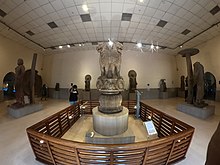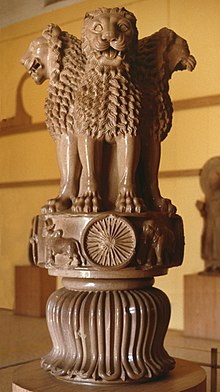350:
276:
440:: "This particular example of a foreign model gets added support from the male heads of foreigners from Patna city and Sarnath since they also prove beyond doubt that a section of the elite in the Gangetic Basin was of foreign origin. However, as noted earlier, this is an example of the late Mauryan period since this is not the type adopted in any Ashoka pillar. We are, therefore, visualizing a historical situation in India in which the West Asian influence on Indian art was felt more in the late Mauryan than in the early Mauryan period. The term West Asia in this context stands for Iran and Afghanistan, where the Sakas and Pahlavas had their base-camps for eastward movement. The prelude to future inroads of the Indo-Bactrians in India had after all started in the second century B.C."... in
292:
307:
324:
336:
366:
45:
166:
668:
29:
216:
52:
154:, the then Director General of Archaeology in India, that this museum was created. The plans were prepared by Mr. James Ramson, the then consulting Architect to the Government of India. The building was completed in 1910 to house, display and study the antiquities in their right perspective. The building forms half of a monastery (Sangharam) in plan.
349:
275:
206:
Of other
Buddhist remains, there is a life-size standing Bodhisattva and a delicate image of the Bodhisattva with a lotus, and yet another bronze sculpture showing the Bodhisattva with multiple arms. The museum at Sarnath also houses a collection of figures and sculptures from the Mauryan, Kushana,
476:
a non-Indian face of a foreigner with a conical hat: "If there are a few faces which are nonIndian , such as one head from
Sarnath with conical cap ( Bachhofer , Vol . I , Pl . 13 ), they are due to the presence of the foreigners their costumes, tastes and liking for portrait art and not their art
199:, the Sarnath museum also houses a collection of other Buddhist artifacts. Among the things to see is a sculpture of the Buddha from the 5th century. The Buddha sits cross-legged, with eyes downcast in deep meditation, and a halo around his head. Also worth exploring are the several figures of the
150:
To keep the antiquities found from the site, a decision was taken in 1904 by the
Government to construct a site museum adjacent to the excavated site at Sarnath. It was due to initiative of Sir
394:
426:
John
Huntington. Understanding the 5th Century Buddhas of Sarnath: A Newly Identified Mudra and a New Comprehension of the Dharmachakra Mudra, Orientations, March 2009, p 84-93
306:
707:
162:
The museum contains five galleries and two verandahs displaying antiquities ranging from the 3rd century BCE to the 12th century AD that have been found at
Sarnath.
260:
are standing back to back. On the far side there is an
Elephant and a Lion instead. The wheel "Ashoka Chakra" from its base has been placed onto the centre of the
291:
646:
485:
The Roots of Indian Art: A Detailed Study of the
Formative Period of Indian Art and Architecture, Third and Second Centuries B.C., Mauryan and Late Mauryan
448:
The Roots of Indian Art: A Detailed Study of the
Formative Period of Indian Art and Architecture, Third and Second Centuries B.C., Mauryan and Late Mauryan
312:
207:
and Gupta periods. Prominent among them is the earliest Buddha image found at
Sarnath and many images of Hindu Gods dating from the 9th to 12th centuries.
232:
This is the famous original sandstone sculpted Lion
Capital of Ashoka preserved at Sarnath Museum, which was originally erected around 250 BCE atop an
323:
697:
570:
404:
717:
493:
456:
712:
365:
519:
473:
44:
692:
192:
images and other ancient remains. Finest specimens of Buddhist art and other important remains have been housed at the museum.
335:
425:
127:
151:
563:
702:
249:
556:
634:
261:
227:
219:
196:
170:
479:
442:
355:
Buddha standing under umbrella, inscribed "Gift of Abhayamira in 154 GE" i.e. 474 CE in the reign of
671:
264:. The fragments of the stone dharma-chakra that was once atop the lions, are now displayed nearby.
399:
91:
489:
452:
722:
639:
297:
174:
653:
341:
165:
184:
has yielded a rich collection of sculptures, artefacts and edifices comprising numerous
356:
282:
686:
253:
241:
233:
139:
28:
608:
245:
483:
446:
593:
437:
281:
Buddha, standing, inscribed Gift of Abhayamira in 154 GE 474 CE in the reign of
257:
200:
189:
598:
215:
534:
521:
618:
603:
613:
135:
80:
372:
237:
181:
131:
130:. It houses the findings and excavations at the archaeological site of
185:
511:
110:
214:
164:
548:
134:, by the Archaeological Survey of India. Sarnath is located near
552:
252:
showing the Horse on the left and the Bull on the right of the
240:. The angle from which this picture has been taken, minus the
195:
While the single most famous exhibit of this museum is the
627:
586:
105:
97:
87:
75:
67:
451:. B.R. Publishing Corporation. pp. 88, 122.
142:. The museum has 6,832 sculptures and artefacts.
564:
8:
488:. B.R. Publishing Corporation. p. 318.
21:
571:
557:
549:
27:
20:
708:Tourist attractions in Varanasi district
385:
271:
256:in the circular base on which the four
51:
7:
395:"A rich repertoire of glorious past"
169:Inside view of the museum, with the
101:Buddhist art, sculpture, antiquities
14:
648:Buddha Preaching his First Sermon
314:Buddha Preaching his First Sermon
126:is the oldest site museum of the
667:
666:
364:
348:
334:
322:
305:
290:
274:
248:flower, has been adopted as the
50:
43:
698:Archaeological museums in India
403:. Varanasi. TNN. Archived from
393:Singh, Binay (26 March 2011).
128:Archaeological Survey of India
18:Archaeology museum in Saranath
1:
74:
718:1910 establishments in India
371:Figure of a foreigner, from
210:
33:Front view of Sarnath Museum
713:Museums established in 1910
512:Official site of the museum
739:
225:
662:
38:
26:
693:Museums in Uttar Pradesh
250:National Emblem of India
535:25.379601°N 83.023081°E
480:Gupta, Swarajya Prakash
443:Gupta, Swarajya Prakash
173:at the center, and the
635:Lion Capital of Ashoka
262:National Flag of India
228:Lion Capital of Ashoka
223:
220:Lion Capital of Ashoka
197:Lion Capital of Ashoka
178:
171:Lion Capital of Ashoka
218:
211:Ashoka's Lion capital
168:
59:Location within India
540:25.379601; 83.023081
436:Page 122: About the
531: /
472:According to Gupta
329:5th century Buddha.
23:
407:on 26 January 2013
400:The Times of India
224:
179:
138:, in the state of
92:Archaeology museum
703:Buddhism in India
680:
679:
495:978-0-391-02172-3
458:978-0-391-02172-3
285:, Sarnath Museum.
121:
120:
113:.sarnathmuseumasi
730:
670:
669:
641:Bala Bodhisattva
573:
566:
559:
550:
546:
545:
543:
542:
541:
536:
532:
529:
528:
527:
524:
500:
499:
470:
464:
462:
434:
428:
423:
417:
416:
414:
412:
390:
368:
352:
338:
326:
309:
298:Bala Bodhisattva
294:
278:
268:Main collections
175:Bala Bodhisattva
117:
114:
112:
54:
53:
47:
31:
24:
738:
737:
733:
732:
731:
729:
728:
727:
683:
682:
681:
676:
658:
654:Sarnath capital
623:
582:
577:
539:
537:
533:
530:
525:
522:
520:
518:
517:
508:
503:
496:
478:
471:
467:
459:
441:
435:
431:
424:
420:
410:
408:
392:
391:
387:
383:
376:
369:
360:
353:
344:
342:Sarnath capital
339:
330:
327:
318:
317:, Gupta period.
310:
301:
295:
286:
279:
270:
230:
213:
160:
148:
109:
98:Collection size
79:Saranath (near
63:
62:
61:
60:
57:
56:
55:
34:
19:
12:
11:
5:
736:
734:
726:
725:
720:
715:
710:
705:
700:
695:
685:
684:
678:
677:
675:
674:
663:
660:
659:
657:
656:
651:
644:
637:
631:
629:
625:
624:
622:
621:
616:
611:
606:
601:
596:
590:
588:
584:
583:
580:Sarnath Museum
578:
576:
575:
568:
561:
553:
515:
514:
507:
506:External links
504:
502:
501:
494:
465:
457:
429:
418:
384:
382:
379:
378:
377:
370:
363:
361:
357:Kumaragupta II
354:
347:
345:
340:
333:
331:
328:
321:
319:
311:
304:
302:
296:
289:
287:
283:Kumaragupta II
280:
273:
269:
266:
226:Main article:
222:in the museum.
212:
209:
159:
156:
147:
144:
124:Sarnath Museum
119:
118:
107:
103:
102:
99:
95:
94:
89:
85:
84:
77:
73:
72:
69:
65:
64:
58:
49:
48:
42:
41:
40:
39:
36:
35:
32:
22:Sarnath Museum
17:
13:
10:
9:
6:
4:
3:
2:
735:
724:
721:
719:
716:
714:
711:
709:
706:
704:
701:
699:
696:
694:
691:
690:
688:
673:
665:
664:
661:
655:
652:
650:
649:
645:
643:
642:
638:
636:
633:
632:
630:
626:
620:
617:
615:
612:
610:
607:
605:
602:
600:
597:
595:
592:
591:
589:
585:
581:
574:
569:
567:
562:
560:
555:
554:
551:
547:
544:
513:
510:
509:
505:
497:
491:
487:
486:
481:
475:
469:
466:
460:
454:
450:
449:
444:
439:
433:
430:
427:
422:
419:
406:
402:
401:
396:
389:
386:
380:
374:
367:
362:
358:
351:
346:
343:
337:
332:
325:
320:
316:
315:
308:
303:
299:
293:
288:
284:
277:
272:
267:
265:
263:
259:
255:
254:Ashoka Chakra
251:
247:
243:
242:inverted bell
239:
235:
234:Ashoka Pillar
229:
221:
217:
208:
204:
202:
198:
193:
191:
187:
183:
176:
172:
167:
163:
157:
155:
153:
152:John Marshall
145:
143:
141:
140:Uttar Pradesh
137:
133:
129:
125:
116:
108:
104:
100:
96:
93:
90:
86:
82:
78:
70:
66:
46:
37:
30:
25:
16:
647:
640:
628:Works of art
609:Buddhist art
579:
516:
484:
477:styles." in
468:
447:
432:
421:
409:. Retrieved
405:the original
398:
388:
313:
258:Indian lions
231:
205:
201:bodhisattvas
194:
180:
177:to the left.
161:
149:
123:
122:
15:
594:Mauryan art
538: /
438:Masarh lion
190:Bodhisattva
68:Established
687:Categories
599:Kushan art
526:83°01′23″E
523:25°22′47″N
411:4 December
381:References
619:Hindu art
604:Gupta art
158:Galleries
672:Category
614:Jain art
482:(1980).
445:(1980).
244:-shaped
136:Varanasi
81:Varanasi
76:Location
723:Sarnath
474:this is
373:Sarnath
238:Sarnath
182:Sarnath
146:History
132:Sarnath
106:Website
492:
455:
186:Buddha
246:lotus
490:ISBN
453:ISBN
413:2012
188:and
115:.org
88:Type
71:1910
587:Art
236:at
111:www
689::
397:.
203:.
572:e
565:t
558:v
498:.
463:.
461:.
415:.
375:.
359:.
300:.
83:)
Text is available under the Creative Commons Attribution-ShareAlike License. Additional terms may apply.




